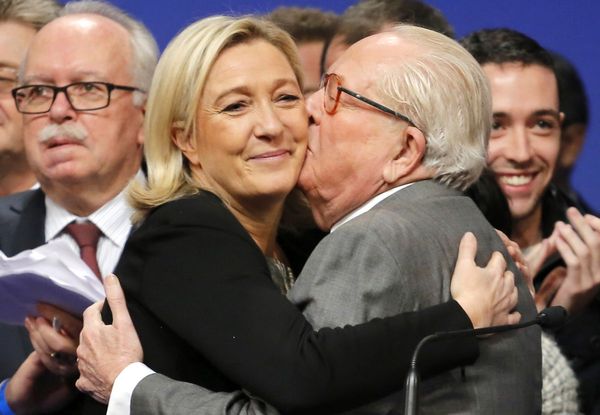MORRIS, Ill. — U.S. Rep. Adam Kinzinger, an Air Force veteran, is again on the frontlines. But it’s a different battlefield for the northern Illinois Republican. This one’s closer to home.
For more than six months, the six-term congressman has been engaged in what he believes to be a fight for the soul of the Republican Party. It's pitting him against loyalists to former President Donald Trump.
It’s a battle for truth that Kinzinger, in a sit-down interview this month with Lee Enterprises, concedes he is not winning — at least not at the moment.
“No, we're not winning,” Kinzinger said. “Do I see signs of progress? Yes. There's a sense that though Trump goes out and speaks, he's not getting the attention he (used to receive), people are ready to move on. What I worry about is that as Trump fades, Trumpism still stays.”
Kinzinger, whose district wraps from Indiana to Wisconsin and includes swaths of Chicago's exurbs and the Illinois Valley, has become one of the former president’s most vocal Republican critics and was one of 10 GOP House members who voted to impeach him in January, citing his role in inciting the insurrection at the U.S. Capitol on Jan. 6.
Since that day, Kinzinger — along with U.S. Rep. Liz Cheney, R-Wyoming — has not missed an opportunity to harangue Trump and his followers in Congress, becoming one of most easily recognizable faces on cable television and Sunday morning talk shows, where he recites a message promoting truth and "Country First," which is also the name of the political action committee he’s formed.
But as certain as Kinzinger is in ultimately winning the argument, his future in politics is unclear, with his path back to Congress potentially blocked by Springfield Democrats who control the redistricting process or by a primary challenge from a pro-Trump candidate.
And though he continues to keep the door open on a possible run for governor or Senate, Kinzinger's conservative politics don’t necessarily play well in a statewide race.
Not that any of this weighs on him.
“So do I want to win? Yes. If I don't win, is it gonna hurt? Maybe a little bit, but I'm not going to have an ounce of regret,” Kinzinger said. “And at no point in my last seven months, particularly since the insurrection, have I ever had an ounce of regret for anything …”
“... Maybe a few tweets,” he quipped.
‘HE’S NOT GOING TO LIE’
Kinzinger, 43, was born in Kankakee and raised in Bloomington. His mother, Jodi, was an elementary school teacher and his father, Rus, ran faith-based homeless shelters in Bloomington and Peoria.
His interest in service started early. In 1998, while a 20-year-old sophomore at Illinois State University, Kinzinger successfully ran for the McLean County Board, defeating a three-term incumbent. This made him the youngest person elected to the board at the time.
“I had initially started going door-to-door, but I looked like I was 14, so I just started calling people on the phone because I sounded older,” Kinzinger said. “And so they elected me and, all of a sudden, they're like, 'Oh we just elected a kid and didn't know it.'”
But the kid took some advice from the county board chairman: “Don’t say anything in a meeting for a year” — basically learn the ropes before speaking.
“That was a lesson I kind of brought back into Congress early,” Kinzinger said. “But yeah, I wish some of the freshmen would just quit trying to be famous and try to actually work.”
“Look at Marjorie Taylor Greene,” he said, referencing his controversial House colleague from Georgia. “Nobody knew who she was. Now everybody knows and that's all she wanted. She doesn't need to be a serious legislator, she doesn't care if she has committees. She's famous, and that's unfortunately why people are coming to Congress now.”
Kinzinger in February joined all Democrats and a handful of Republicans in voting to strip Greene of her committee assignments over past racist and anti-Semitic remarks as well as her well-documented promotion of conspiracy theories.
Those who know Kinzinger say his fight against these elements of the Republican Party is in line with his background.
“It's not surprising to me that amidst all kinds of really crazy conspiracies ... that Adam Kinzinger is the one who says, 'No, I'm the grown-up in the room," said Tari Renner, the former two-term Democratic mayor of Bloomington and a political science professor at Illinois Wesleyan University.
Renner was elected to the county board the same year as Kinzinger. Though from different political parties and generations, the two became “close pals within about a year,” he said.
“We could trust each other, I guess it's safe to say,” Renner said. “You could certainly trust Adam. He's not going to lie, he's not going to stab you in the back or be wishy-washy. Or, if he's on the fence, he's legitimately conflicted.”
Kinzinger would answer a higher call to service in 2003, resigning his county board seat to join the U.S. Air Force, where he was commissioned a 2nd lieutenant and would later earn his pilot wings. He flew missions in Iraq and Afghanistan and continues to serve as a lieutenant colonel in the Air National Guard.
In 2010, it was back to politics. Riding the tea party wave, Kinzinger defeated Democratic incumbent Rep. Debbie Halvorson by a 14-point margin in a district based in rural and exurban areas southwest of Chicago.
Following redistricting, he was drawn into a district with fellow incumbent GOP Rep. Don Manzullo, whom he subsequently defeated in a primary election. No one has come close to beating him since.
‘GIGANTIC’ LEVEL OF DISSONANCE
Kinzinger’s voting record in Congress is standard for a Republican. He’s a fiscal conservative with a hawkish streak on foreign policy, but typically votes the party line. This included taking Trump’s position more than 90% of the time, according to FiveThirtyEight.
Though a reliable conservative vote on matters of policy, Kinzinger has displayed independence at times during his congressional career. Before his vote to impeach, the most clear example was his decision not to vote for Trump in 2016. He reversed himself and voted for the former president in 2020, a vote he now regrets.
The hawkish Kinzinger also has never been shy about taking on certain elements of Trump’s "America First" foreign policy. He harshly criticized Trump’s decision to remove U.S. troops from Syria in 2019, for instance. And in 2020, Kinzinger started posting a series of videos to social media denouncing conspiracy theories like QAnon.
But it wasn’t until after the 2020 election that Kinzinger started to feel the wrath from Trump and his supporters, first by not spreading the "Big Lie" that the election was stolen from the former president.
Then, following the Capitol insurrection, Kinzinger called for Trump to be removed from office via the 25th Amendment. A week later, he voted for impeachment.
Several Illinois county Republican organizations voted to censure Kinzinger for his vote. He’s now attracted at least a half-dozen primary challengers should he decide to run for reelection in 2022.
Some members of his own extended family have disowned him for his stance.
And he’s facing the squeeze within the House GOP Conference. He hasn’t spoken with House Minority Leader Kevin McCarthy, R-California, in months. And when asked by reporters earlier this month about McCarthy’s threat to strip any GOP member of their committee assignments if they participated on a Democrat-created panel investigating the events of Jan. 6, Kinzinger replied, “Who gives a (expletive)?”
Kinzinger said there’s a “gigantic” level of dissonance between what his colleagues say in public versus what they believe in private about Trump and the current state of the GOP.
No constituents mad over his position on Trump have confronted him thus far. But, Kinzinger isn’t naïve to think that he hasn’t made some Republican voters in his district angry. He just thinks there are more people who agree with him than the conventional wisdom might suggest.
There’s just not much evidence to prove that yet. It’s the opposite, in many cases.
Perhaps most stinging, a candidate backed by Kinzinger’s Country First PAC came in fifth place in a special congressional election in Texas a few months ago.
“We have too many leaders manipulating people for their own sake and they don't know what the end state is, which is destruction, frankly, of the country,” Kinzinger said. “So I'm going to continue to fight, and I do believe ultimately we prevail because the alternative is not only does my faction not prevail, the party falters and fails, and I think the country can't sustain that.”
THE FUTURE
Kinzinger’s next fight may be his own: His future in Congress is fairly unclear.
Even before having to face Republican voters in a primary, Kinzinger is at the mercy of Springfield Democrats, who control the once-a-decade congressional redistricting process.
State legislative Democrats are under pressure from the national party to draw a favorable map that helps shore up the party’s fragile majority in the House. With the state losing a seat due to population loss, this at a minimum means protecting all 13 Democratic incumbents while eliminating a downstate GOP district.
Besides the remap, the primary election is the other threat. At least a half-dozen Republicans, most pro-Trump, have announced challenges to Kinzinger.
But if Kinzinger’s worried, he isn’t showing it.
“I would remind everybody who's talking about this primary coming up, every primary I've had, I have absolutely crushed the face of my opponent,” Kinzinger said. “And those were even times when people would make up stuff like, 'I'm not a true conservative.' These same factions I have beaten repeatedly and I fully expect to crush them again.”
And Kinzinger starts with some key advantages, namely name recognition and money. He just had the two best fundraising quarters of his career, raising more than $1.1 million in the first three months of the year and more than $800,000 since April. He now has more than $3 million cash on hand.
His next-closest opponent, Catalina Lauf, a former Trump appointee to the U.S. Department of Commerce, had just over $141,000 in the bank. No other candidate has raised more than $12,000.
Renner said this would help Kinzinger, whose “best chance of surviving would be in a divided primary field,” he said.
Kinzinger said, once again, that he would prefer to return to Congress. But, a potential run for governor of Illinois? He is “not ruling that out” either.
Kinzinger said it’s “really tough” for a Republican in a statewide race, but “the right candidate can win.” He’s not yet sure that’s him, but he is certain that candidate isn’t in the race yet.
Declared candidates include state Sen. Darren Bailey, R-Xenia; former state Sen. Paul Schimpf, R-Waterloo; and suburban Chicago businessman Gary Rabine.
But for now, Kinzinger says, he is focused on getting the truth out to a large-enough audience.
That means building up his Country First PAC, which will endorse candidates in 2022. The goal, he said, is to build a movement dedicated to the truth, even if success isn’t guaranteed.
“If I had the formula, I'd be implementing it, but maybe that'll become evident,” he said. “Here's what is evident: I can't do it by myself. And I need people that agree to join up and to speak up. It is so much easier to be silent. Trust me, I would love to be silent, but you just can't.”







